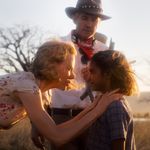
Calvin Evans, this is your life. Last week, we learned a little more about where Elizabeth came from. This time, thanks to Mad’s detective work and her discovery that connected her father to none other than the kind Reverend Wakely, we get a deeper dive into Calvin’s story. While getting a richer understanding of Calvin — and more screen time with Lewis Pullman — is a real win for us all, is reminding us of what we lost simply, as Calvin would put it, “salt on a corroding wound?” Yeah. Definitely. I hate this, and I love this. It’s torture. But, like, in a good way.
Before we learn just how Calvin and Wakely are connected, we first find little Calvin at the St. Luke’s Boys School, the orphanage where he grew up. He’s sneaking Chemistry books during Bible Studies class, he’s getting demerits for being tardy (thank goodness, right?), and he’s running the underground bootleg hooch business for the head priest at St. Luke’s, who is making some real bucks off his orphan labor. I know that last thing might sound made up, but it is not! It is real! And not surprisingly, Calvin’s great at it. Also, not surprisingly, the priest running the illegal operation is a real piece of shit. When Beau Bridges — told ya he’d be back — arrives at St. Luke’s one day, Calvin is sure he must be there for him. When Calvin asks if the man is his father here to take him home, the priest never confirms or denies if this man is Calvin’s family, but he does tell this sweet, impressionable kid that the man was here for him and after learning about him and seeing him, he didn’t want him. The priest is definitely lying, but we don’t know the full extent of those lies. He clearly wants to keep Calvin around for his lucrative booze business — so did he lie to Beau Bridges about Calvin, or was Beau Bridges there for some other reason? We don’t have the details yet. We do, however, know that to get Calvin to drop the subject entirely, this creep tells him that he’s better off without his family, who are clearly awful, and that because of them, he is and always will be broken. It’s a lie that becomes part of Calvin’s fabric.
When we meet Calvin again, he’s working at Hastings Lab and getting photos taken for his big Scientific American cover. He is wildly closed off, and his temper is on full display. Here, he demands his own solo lab and then jets off to Boston to lecture at Harvard. What might seem like your run-of-the-mill lecture becomes integral to Calvin — and to this series. Sitting in the lecture hall, taking in Calvin’s lesson, is Curtis Wakely. He’s in divinity school but still interested in what this genius scientist has to say. He’s so interested, in fact, that he decides to write him a letter. The two, though fully aware of their differing beliefs, become pen pals. Their friendship begins with discussions of science versus the divine and passing around Darwin’s The Descent of Man, but soon enough, it becomes more personal.
Calvin shares that he has no wife or family, that he’s married to his work, and thinks it’s best that way. Wakely writes about his anger over his father turning to prayer instead of medicine for his gallbladder cancer. The two men help each other in simple but life-altering ways. Wakely tells Calvin that “no one is best alone” and that he should open himself up to “unknown variables” — the results might surprise him. After some tragic first dates — Calvin is not everyone’s cup of tea, and that’s why we love him! — he happens upon Elizabeth Zott and, thanks to Wakely (and spending time with Harriet and Charlie Sloane, who might be called “couple goals” should that have been a thing in the mid-twentieth century), is willing to be vulnerable. In turn, Calvin sends Wakely a bunch of research on cutting-edge treatments for gallbladder cancer, and his words and his science convince Wakely’s dad to undergo treatment, saving his life. Wakely’s dad comments on the “coincidence” in the timing of this friendship, and Wakely remarks on it to Calvin, too, telling him that if anything, this friendship that has changed them both must be evidence of the divine. They don’t even know the half of it, man.
While our little trip back to the before times when Calvin and Elizabeth were falling in love in labs and on ergs — two inherently unsexy things, and yet? — mostly runs through the highlights that we already know about, there are few new moments within their short time together.
Remember how Elizabeth found an engagement ring in Calvin’s personal effects even though they expressly talked about marriage not being for them? We get a little closure on that. Calvin finds himself falling completely in love with Elizabeth. In a letter to Wakely, who had previously described life as “science being the how and religion being the why,” Calvin tells his friend that the woman he’s met is both his “how and [his] why” and that he wants to give everything to her and be everything for her, after which I needed to hit pause and have a little lie-down. Are chemists this romantic in real life, Y/N? So full of love, Calvin wanders into the jewelry store and completely ruins the shop girl’s future with men by continuing to be so unbelievably romantic, if not a bit of an oversharer. In his defense, Calvin does apologize for talking so freely to a stranger. She helps him find the perfect ring, understated and yet complex. Watching Calvin become crippled with nerves as he tries to find the right time to propose is a delight, and of course, we know that once he finds out Elizabeth doesn’t want to get married, he will never force it on her. The ring remains in his lab coat.
He hesitates for so long because he worries that once he does, the spell might be broken, and Elizabeth might realize she is entirely too good for him. I mean, clearly, we know why this man has fears of abandonment and why, even though he is a genius in his field, he feels like he’s damaged goods. Those insecurities are inescapable within his relationship with Elizabeth. He worries that if she sees any of his dark side, she’ll leave. His theory, however, is very much wrong. One day, with the stress of the Remsen Grant hitting him hard, a well-meaning mailroom kid delivers letters to Calvin that he had instructed Hastings to forward directly to his lawyers so they could issue cease and desist letters (thanks, Harriet!). After his Scientific American write-up, people began reaching out to him, claiming to be family and asking for money, among other things. Calvin is enraged when he sees these letters still arriving (including that one from Avery Parker), and he lashes out at the mailroom guy before ranting about no one appreciating the work he’s trying to do, which is frustrating for Elizabeth to hear, and she leaves.
He assumes that his worst fear has come true — Elizabeth has seen him at his worst and wants no part of him. But he is wrong. Elizabeth is waiting for him at home. She loves him, and she just wants to know what the hell happened there. So, he tells her. He tells her about how his parents actually abandoned him before they died, that the letters from these grifters only rehash those wounds, and that he’s glad his parents are dead. And she still loves him. Of course she does. What a real ding-dong. Calvin writes another letter to Wakely, telling him that he thinks he wanted to propose because he was compensating for not being enough, but he was wrong about a lot of things. “Marriage may not be for us, but we are for each other. We are for each other. That sums up the whole damn universe, wouldn’t you say?” Calvin writes. I cannot believe they killed off this man! This! Man!
But they do kill him off. They kill him off right after he puts a stamp on this letter and sticks it in his mailbox. We have to watch the whole thing all over again. Suddenly, the lab, the street where he ran, the river where he rowed, are all empty. Wakely responds to this letter — informing Calvin that he and his family are about to move to California, so maybe they could meet in person — but that letter comes back to him with a big “return to sender” stamp on it. Now, Wakely, who is apparently a huge Agatha Christie fan and so into mysteries that he’s willing to help an odd little girl who shows up in his church with some detective work, and yet … he didn’t once look into what happened to Calvin or try to find his very good friend’s soul mate? That’s insanity.
In Lessons in Chemistry’s present day, Wakely arrives at the Zott house and gives them all the letters Calvin wrote to him and finally gets to put a (familiar) face to the woman Calvin spoke so highly of — Calvin’s unknown variable. It’s a nice moment. But then Mad and Elizabeth are off to St. Luke’s — I mean, someone needs to follow up on all these loose strings.
Wouldn’t you know, the same priest who destroyed Calvin’s sense of self is still running the place. And he remains, as ever, a real asshole. When Mad asks him about her father, Calvin Evans, he lies and tells her he doesn’t remember anyone by that name and all of the files from that time were conveniently lost in a fire. Mad is smart enough to know he’s not telling her the truth, but that doesn’t make her any less angry. She won’t give up; she knows there must be some evidence that her father was here. Elizabeth finds her daughter on the floor of the library, scouring the books for some remnant of Calvin.
Friends, she finds one. On the library card tucked inside Great Expectations — a novel we see Elizabeth tease Calvin about for reading so many times and then later giving to Mad to read — is little Calvin Evans’s name. While yes, that does give Mad the satisfaction of knowing her father lived in this very place, it gives Elizabeth something more — a real lead to figuring out Calvin’s story. Inside the novel is a stamp that reads “donated by the Remsen Foundation.” Now, things like Calvin and Wakely striking up a friendship just as they need counsel from one another might be a coincidence, but this is not. And if the stamp doesn’t signal that to you, perhaps that shot of Beau Bridges leaving his office at the Remsen Foundation and passing by an enshrined copy of Calvin’s Scientific American will do it. There’s more mystery for Mad to solve.




